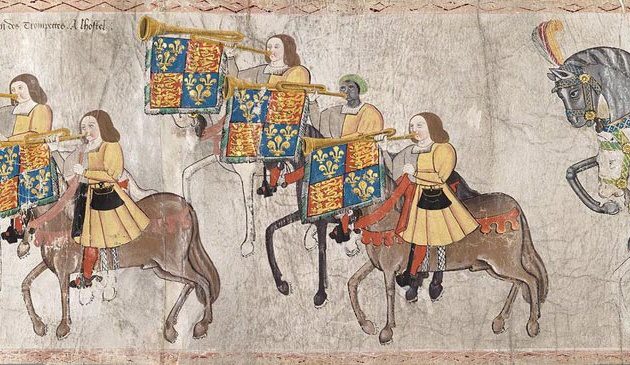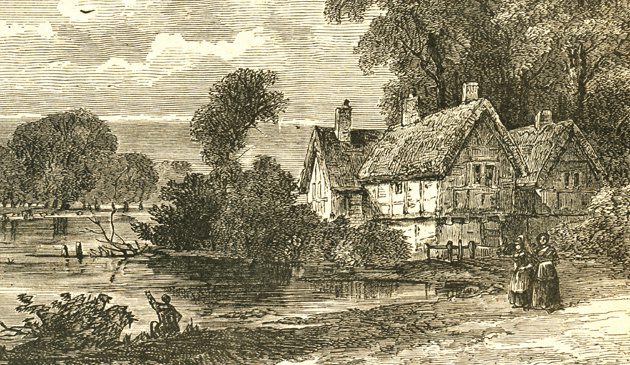The Port of London in the Tudor period

A view of the Thames c1550
A group of English traders known as the Merchant Adventurers had emerged in the 15th century, dominating the booming business in English cloth to Antwerp. They were wealthy enough to lend money to the Crown and were thus supported by the monarchy. Royal letters patent were drawn up in 1505 to bring them together as a single company and provide them with a monopoly on the export of cloth by English merchants. London gradually came to dominate the cloth export trade.
Another group exporting cloth was the Hanse. England’s trade with the Baltic area was blocked by the Hanse’s monopolies and Edward VI was petitioned to support the English merchants. In February 1552 he revoked the League’s rights in England and the Steelyard was seized but two years later their rights were restored by Queen Mary. When the Hanse attempted to block English grain exports to the Low Countries English merchants petitioned Queen Elizabeth. In 1598 the Hanseatic League were given two weeks to vacate the Steelyard they had occupied for several centuries and it was closed, becoming a naval storehouse. The departure of the Hanse from London provided the Merchant Adventurers with a near-monopoly on cloth exports to the Continent.
Many goods also passed through Calais, England’s last remaining territory on the Continent, but it was lost to the French in 1558 during the reign of Queen Mary and that disrupted London’s trade with the Continent. Further problems were caused by political differences with Spain that blocked English access to Antwerp, then within the Spanish Netherlands, as well as the importation of products from the Mediterranean that came via Spain. Some London merchants sought new trade routes that would allow them to trade directly with markets further afield.
Trade with China and the East Indies via the southern coast of Africa was under the control of Portuguese ships. In 1548 Sebastian Cabot persuaded members of the Merchant Adventurers to raise finance in order to look for a new north-east passage to the Far East, seeking supply of spices and gold. London’s merchants and courtiers subscribed £6,000 for the venture. In May 1553 Sir Hugh Willoughby and Richard Chancellor sailed from Ratcliffe but their three ships were separated in a storm. That winter the one carrying Willoughby became trapped in Arctic ice and he and his crew perished in the cold. Chancellor and his crew reached the harbour of Nikolo-Korelsky from where he was invited to Moscow by the Tsar, Ivan IV (Ivan the Terrible). Chancellor and the Tsar struck up a trade agreement that took English cloth and other goods to Russia in return for Russian furs and naval supplies. In 1555 Chancellor returned to London and the Muscovy Company was formed. Queen Elizabeth became one of its shareholders and it was given a monopoly on English trade with Russia. It was the first English long-distance joint-stock company and its influence on the future of London as a trade centre was enormous. For over two decades the Muscovy Company was able to trade overland through Russia as far as Persia until that route was cut off by the Turks in 1580.
In 1551 a group of London investors sponsored Captain Thomas Wyndham to sail to the Mediterranean on his ship the Lion of London. He returned the following summer with sugar, dates, almonds, and molasses. This initiated a regular trade with Morocco and in return England exported cloth and weapons. One of the most important goods brought back from Morocco was saltpetre, a key ingredient for gunpowder.
International shipping and trading was a lucrative but risky business and merchants needed to share that uncertainty rather than the danger of losing everything. Syndicates continued to be formed as joint-stock companies to share the risk and control the market. As a reward for their investment in the voyages of discovery and in forming new trading posts each company was given a monopoly on dealings with their particular area of the world. This led to the formation of a number of other English joint-stock companies, including: the Spanish Company (1579) with Spain and Portugal (1573); the Eastern Company around the eastern Baltic sea; Morocco Company (1585) to northern Africa; the Turkey Company (1581), formed mainly by Muscovy and Spanish Company merchants to trade with Turkey; and the Venice Company (1583). An important aspect was that membership of these companies was restricted to merchants, to the exclusion of shopkeepers, artisans and ships’ captains who would all have the ability to undercut the merchants.
In 1592 fifty-three Turkey and Venice merchants joined together to form the Levant Company to trade with the eastern Mediterranean and from there overland to the Far East. Within a few years the Dutch had broken into the Far East trade with voyages around the Cape of Good Hope and members of the Levant Company followed, for which they created the separate East India Company. The first voyage to the Far East was made in 1601.
The Merchant Adventurers business was exporting cloth. These newer companies established to trade with Russia, the Mediterranean, and the Near and Far East primarily existed to import goods; any products they exported were merely as a means of part-payment for the cargoes being brought back to London. Those merchants were wealthy and powerful men from the City of London, many of whom were aldermen and Members of Parliament. They had strong links to the Royal Court, for whom their activities were useful as diplomatic missions as well as a lucrative source of Customs duties. They formed an almost entirely separate group to the longer-established Merchant Adventurers.
Those who formed the joint-stock companies needed convenient places to meet and undertake their complex business together so the first steps were made that were to turn London into a major financial centre. Until the late 16th century one of Europe’s main money markets was in Antwerp and it was there that the London merchant Thomas Gresham acted as Crown Agent to raise finance for the English monarchs. Having first-hand experience of the bourse in Antwerp he decided to open such an institution in London, where merchants could meet to transact business. The first building was opened in the City in 1567 at the junction of Cornhill and Threadneedle Street. In 1571 Queen Elizabeth visited and thereafter it was known as the Royal Exchange. Antwerp’s golden period as the cultural and financial centre of northern Europe ended in 1585 when a large part of the Protestant population fled following a siege by the Catholic Spanish. Some bankers emigrated to London and thus enhanced the City as a major European finance centre.
The Anglo-Spanish wars during Elizabeth’s reign caused disruption to England’s overseas trade. Many of London’s merchant ships and crews either joined hostilities or sailed as privateers – licensed pirates – during that time. It was necessary for Levant Company ships to be well-armed to prevent capture by Turk or Barbary pirates in the Mediterranean, so they were already well-placed to undertake privateering. It was a lucrative business for England and London’s merchants invested vast amounts of money sponsoring voyages. From 1580 Spain and Portugal were united under one king and several of London’s Levant Company merchants amassed great fortunes by seizing the cargoes of Portuguese ships returning from Brazil with valuable consignments of sugar. When Francis Drake sailed to Cadiz in 1587 his fleet included seven London ships. Around 30 London ships sailed in the fleet that set out to meet the Spanish Armada in 1588. Many of the crewmen of those vessels would have been Thames watermen who had been press-ganged into service.


